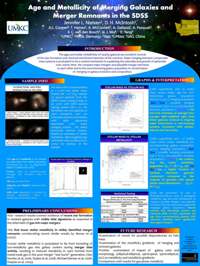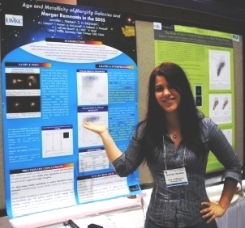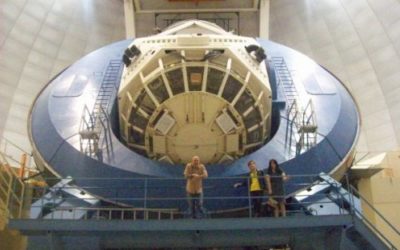UMKC student wins prestigious astrophysics research award
Daniel McIntosh, an astronomy professor in the College of Arts and Sciences’ Department of Physics, recently took three UMKC physics students — Jennifer Nielsen, Andrew Cooper and Cory Wagner — to present original research at the 217th American Astronomical Society (AAS) Conference in Seattle. One of these students, Jennifer Nielsen, returned home with a Chambliss Astronomy Achievement Student Award medal for research on the chemical composition of merging galaxies.
The research was completed with Prof. McIntosh over the past year as part of the Galaxy Evolution Group. The Chambliss awards recognize exemplary research by undergraduate and graduate students who present posters at the semi-annual meetings of AAS. Literally hundreds of posters from students around the world filled the exhibit halls.

Jennifer Nielsen’s award-winning poster, “Age and Metallicity of Merging Galaxies and Merging Remnants in the SDSS.” Click on image for larger view.
Nielsen says that she could not have done this without Prof. McIntosh’s mentorship and guidance. She took part in his Physics 499 Research class senior year and became hooked on galaxy research. Over her years at UMKC she was also inspired by classes with Dr. Keith Ashman (astrophysicist, retired) and by extensive involvement with the UMKC Chapter of the Society of Physics Students, of which she was president for two years.
“The education provided by the UMKC physics department and the research opportunities the department provides are truly stellar,” she says.
Prof. McIntosh, who teaches the Introduction to Astronomy (Physics 150 and 155) sequence, plus Astrophysics I and II (Physics 355 and 356),at UMKC offers research opportunities to undergraduates of all disciplines wishing to try their hand at serious astronomical research while taking undergraduate classes.
“Basically, our team is very interested in how galaxies grow, specifically by colliding into other galaxies and merging,” Nielsen says. “My research is helping to show that the violent tidal forces at work when galaxies merge irrevocably impact and change galaxy composition, and supports the idea that there is a major star burst (a burst of star birth activity) after galaxies merge and coalesce. When galaxies merge they swirl around each other — they look a lot like mating fish — and then finally slam together and become one larger, spherical galaxy.”
Astronomers know how merging happens and how it looks because of models and simulations that are based on known, tested physics, and because scientists are able to take “snapshots” of these mergers in action through the Sloan Digital Sky Survey, Hubble Space Telescope, and other telescopic media. The process itself must be caught in various stages rather than watched all at once, because it actually takes many hundreds of millionsof years.
“My team has looked at literally tens ofthousands of photos and worked through much data from the Sloan Digital Sky Survey in an effort to better understand what is going on,” she says. “I’m also working with the largest Hubble Survey ever up to this point, called CANDELS (See http://candels.ucolick.org/team_info/Team_Members.html), and I’ve recently accompanied my advisor, Dr. Daniel McIntosh, and other students in our group to help take new galaxy images at the WIYN telescope at Kitt Peak National Observatory near Tucson, Arizona.”
“It’s very exciting that I’ve been able to participate in so much cutting-edge research as an undergraduate and I think it says a lot for the quality of UMKC in general, and especially Dr. McIntosh’s mentorship and our UMKC Physics Program.”
Quick 5: Jennifer Nielsen
1. Where were you born and raised and where did you go to high school?
 I was born in Kansas, raised in Missouri and I was homeschooled by my amazing parents from Kindergarten through 12th grade. I graduated from a distance learning program, Keystone National High School.
I was born in Kansas, raised in Missouri and I was homeschooled by my amazing parents from Kindergarten through 12th grade. I graduated from a distance learning program, Keystone National High School.
2. When/how did you first become interested in science/astronomy
I’ve been looking up at the stars and wondering about space ever since I can remember. When the Hubble photos started being popularized over the internet in the late 90s I really jumped on the topic. I got my own telescope, started saving interesting science stories and publishing my own science newsletter.
3. Why did you decide to come and what attracted you to UMKC?
UMKC is very strong in sciences and the physics department had many undergraduate research opportunities available, along with an active Society of Physics Students chapter.
4. What are you doing now?
I’m taking a bit of time “off” from school before graduate school to work for Daniel McIntosh as a research assistant, write a paper based on my galaxy research, study for my GRE’s, and finish writing a novel. I think taking some time off after graduation, especially if you can do research in your field during the interim, can be a good thing. I was hooked on energy drinks and super exhausted in general when I first graduated and now I’m my enthusiastic self again and already missing school!
5. What do you hope to be doing five years from now?
I want to have my doctorate or be close to finishing it, to be doing research, making discoveries (great or small) and sharing my enthusiasm with people via teaching or some form of popularizing science. I’m sort of a grail chaser — I feed off of awe at the universe — and I’m always looking for inspiration and to inspire.

